Pasta con le sarde a mare
(English speaker? See the English version!)
Da quando sono andata in Sicilia, ormai un mese fa, coltivo una inaspettata ossessione per un ingrediente che in passato conoscevo e usavo poco: il finocchietto selvatico.
E’ una fortuita coincidenza il fatto che per la puntata di questo mese di Italian Table Talk, il progetto sulla cucina italiana che condivido con le amiche Giulia, Valeria ed Emiko, sia capitato proprio il tema delle erbe spontanee: quale occasione migliore per confessare la mia mania per il finocchietto selvatico?
Questa pianta generosa, che cresce spontaneamente quasi senza limiti di territorio o di clima, si presta a tantissime preparazioni, come ad esempio le insalate, le polpette, e naturalmente la pasta, come nella nostra ricetta di oggi.
Il finocchietto selvatico è una pianta preziosissima, sia per le proprietà benefiche sia per il particolare aroma che dà al cibo: se ne usano sia le foglie tenere che i semi, che hanno proprietà diuretiche, anti-infiammatorie e depurative.
Quello che amo del finocchietto, oltre naturalmente al sapore, è proprio la sua natura di erba spontanea: se il clima è appena appena accogliente, il finocchietto cresce praticamente da solo, in qualsiasi terreno, con pochissima cura salvo l’abbondante irrigazione.
Io coltivo il finocchietto sul balcone della mia stanza, qui a Milano, in un grande vaso, ma sarebbe preferibile raccoglierlo in campagna lontano dalle strade trafficate.
Le foglie si raccolgono in primavera, quando sono molto tenere: vengono utilizzate fresche ma si possono anche sbollentare e surgelare per farne scorta.
I fiori invece si raccolgono tra Agosto e Settembre, quando sono ben aperti: dopo la raccolta, bisogna farli essiccare all’aria aperta per poi estrarne i semini.
I semi del finocchietto selvatico, una volta essiccati, si usano per preparazioni al forno e alla griglia, per condire la verdura, oppure nelle tisane, perchè fanno molto bene.
Le foglie del finocchietto, invece, sono molto fresche, aromatiche e appena amare: sono adatte per condire la pasta, o per accompagnare le carni bianche, o ancora per farne deliziose polpette, oltre che – naturalmente – in insalata.
La ricetta di oggi, che contiene il mio prezioso finocchietto, è la pasta con le sarde a mare, la versione veggie della classica pasta con le sarde palermitana.
La storia di questo piatto è molto interessante. Ai tempi della guerra, quando il pesce costava molto caro, le cuoche siciliane preparavano la pasta con le sarde omettendo appunto le sarde, che erano un lusso per pochi: così è nata la pasta con le sarde a mare, cioè la pasta con le sarde… in cui le sarde rimangono in mare!
Potete trovare questa ricetta e moltissime altre nel bel libro di Fabrizia Lanza, Coming Home to Sicily, un volume che – credetemi! – non può mancare nella vostra libreria.
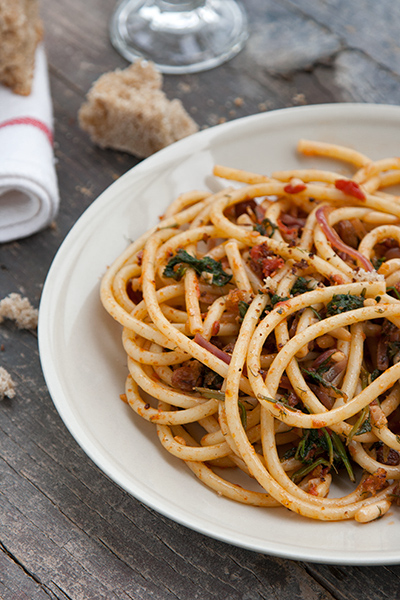
Pasta con le sarde a mare
Ingredienti
- 200 g di foglie di finocchietto selvatico lavato alla perfezione
- 200 g di bucatini/spaghetti
- 1 spicchio d'aglio schiacciato o tritato finemente
- 1/2 cipolla rossa di Tropea affettata sottile
- 5 cucchiai di passata di pomodoro
- 1/2 cucchiaio di concentrato di pomodoro
- 20 g di pinoli
- 20 g di uvetta precedentemente ammollata
- 50 g di briciole di pane secco
- 1 pizzico di peperoncino
- 1 presa di zucchero
- vino bianco
- olio extravergine d'oliva
- sale e pepe
Istruzioni
- Lessate i finocchietti in abbondante acqua bollente salata per circa 10 minuti, poi scolateli bene, tenendo da parte l'acqua di cottura.
- In una padella capiente, fate un soffritto di aglio e cipolla, poi aggiungete l'uvetta, i pinoli, il finocchietto tritato al coltello e la passata.
- Sciogliete il concentrato di pomodoro in un bicchiere di vino bianco, poi versate il tutto in padella e fate evaporare il vino a fuoco vivace.
- In un padellino a parte, fate dorare le briciole in poco olio d'oliva, con una presa di zucchero e un pizzico di peperoncino.
- Nel frattempo, cuocete la pasta nell'acqua di cottura del finocchietto precedentemente tenuta da parte.
- Quando la pasta è cotta ma ancora al dente, scolatela, fatela saltare in padella nel sugo e impiattate.
- Prima di servire, aggiungete su ogni porzione una generosa spolverata di briciole.
Non siete ancora sazi? Passate a scoprire i post di Giulia, Valeria ed Emiko dedicati alle erbe spontanee, e non dimenticate di seguirci su Twitter con l’hashtag #ITableTalk!
Since I came back from Sicily, a month ago, I have become increasingly obsessed with wild fennel, a typically Sicilian ingredient I wasn’t used to cooking with before I tried it first hand on my trip to the island.
It’s a very lucky coincidence that foraging is the chosen theme for this month’s issue of Italian Table Talk, the lovely project about Italian food and traditions which I proudly share with my friends Giulia, Valeria and Emiko: this is the perfect opportunity for me to tell you about my wild fennel frenzy.
Wild fennel is a very generous plant: it grows basically everywhere, provided that the weather is mild, and can be used in a variety of preparations, such as salads, meatballs, sausages, pasta sauces – like the one we will learn together today – and many more.
Not only it has a delightful flavour, but also healing properties: it’s branches and leaves are good for cooking, while its seeds are duretic, anti inflammatory and highly depurative.
What I also love about fennel is the fact that it really grows spontaneusly: every soil will do, as long as you plant your wild fennel plants in a big pot and water them often.
I grow my wild fennel on my room’s balcony, here in Milan, and dispite my not-very-green-killer-thumb I still manage to get all the fennel I need for cooking quite effortlessly.
It would be better to collect wild fennel in the countryside, away from the traffic jams of the city centre, but I’m no country girl, so I do what I can at home.
Wild fennel leaves and bulbs are to be cut during Spring, when they’re green and tender: we use them fresh or boil them and freeze them for later usage.
Flowers, on the other hand, are collected between August and September, when they’re in full bloom: they have to be dried in the open air, so that later on seeds can be extracted.
Once dried, fennel seeds are mostly used for meats that are grilled or oven baked, for veggie stews and for herbal teas.
Leaves and bulbs, on the other hand, being fresh and aromatic, are used in salads, meatballs, and pasta sauces.
The recipe I’m showing you today is called pasta con le sarde a mare, and it has an interesting story.
Pasta con le sarde, pasta with fresh sardines, is a typical Sicilian food, originated in the area of Palermo. During wartime, when fish was very expensive, Italian women who could not afford fish would prepare traditional pasta con le sarde omitting sardines: that’s how pasta con le sarde a mare, meaning “pasta with sardines in the sea”, was invented!
This recipe can be found in Fabrizia Lanza’s Coming Home to Sicily, the best cookbook about Sicilian food you could ever want.

Pasta con le sarde a mare
Ingredienti
- 1 pound wild fennel fronds leaves and tender stems
- 2 pounds spaghetti/bucatini
- 1 cup extra-virgin olive oil
- 1 red onion finely chopped
- 2 garlic clove peeled and smashed
- 3 cups tomato sauce
- 1/2 cup pine nuts
- 1/2 cup dried currants
- 1 tbsp sun dried tomato paste
- 1/2 cup white wine
- 2 cups unseasoned dried breadcrumbs
- 1 pinch ground hot pepper
- 1 tbsp sugar
- salt and pepper
Istruzioni
- First of all, we will make the sauce. Cook the wild fennel in a large pot of boiling salted water until tender, for 10 mins or so. Drain well in a colander and let cool, then chop and set aside.
- Combine the olive oil, onion and garlic in a large saucepan and cook on medium-high heat until the onion is softened, for some 5 mins.
- Add the tomato sauce, pine nuts, currants, and blanched wild fennel.
- Stir the tomato paste into the wine until dissolved, then add to the sauce. Season with salt and pepper and let simmer for 10 mins.
- In the meantime, make the breadcrumb topping: combine breadcrumbs and olive oil with sugad and hot pepper ina little skillet and cook, stirring constantly, until the breadcrumbs are golden brown, then set aside.
- Cook the pasta al dente in a large pot of salted boiling water, then drain in a colander and stir into the sauce pan.
- Transfer the pasta to a serving platter and garnish with the seasoned breadcrumbs.
- If you want to make proper pasta con le sarde instead of pasta con le sarde a mare, that is to say including sardines, add a pound of fresh sardines to the sauce.
Check out more interesting stories about foraging and related delicious recipes visiting my fellow Italian Table Talk bloggers, Giulia, Valeria and Emiko, and join the conversation with the hashtag #ITableTalk on Twitter.



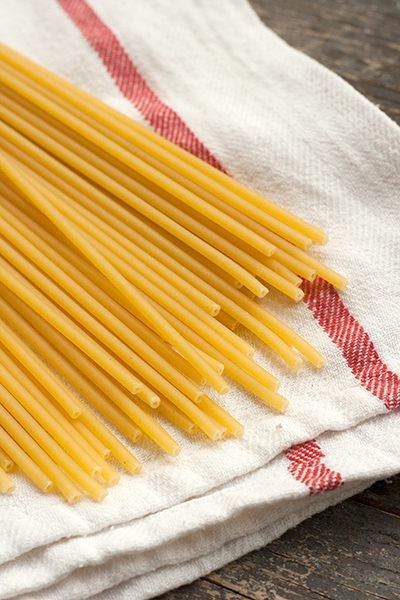
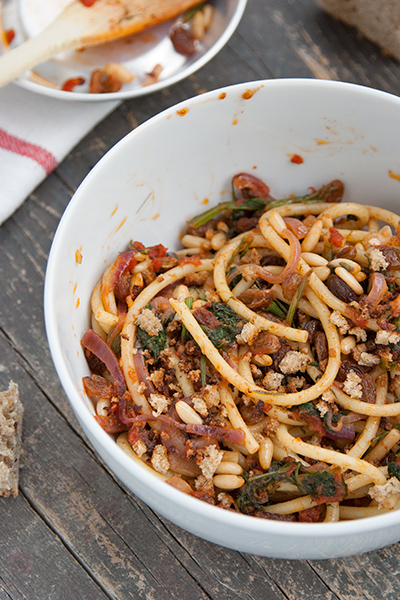

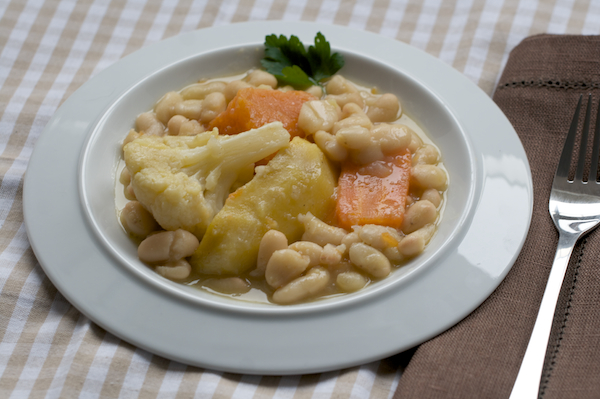
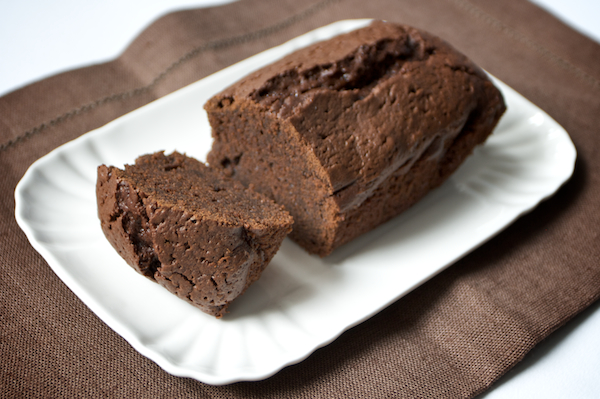
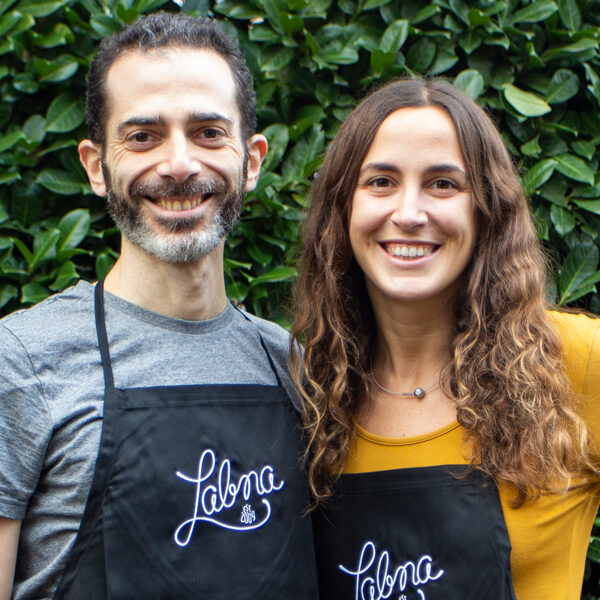
Stessa mania per il finocchietto selvatico, con l’aggiunta che a me ricorda le mie vacanze in bici a Favignana, a respirare quel profumo intensissimo mentre pedalavo controvento. Grazie della ricetta, stavo giusto cercando qualcosa per usare quello che ho sul balcone!
Buona settimana, Elena
Adoro le cipolle rosse di tropea, peccato si trovino solo in Calabria.
I must admit I’m slightly addicted to fennel, I eat it a few times a week and drink fennel tea all day long every day. I love how versatile it is and how cleansing it tastes. I have a pack of buccatini I’ve been saving – you don’t find it easily here- and I think I might use it on this recipe – minus the currants though, or mt sweetheart won’t eat it ;-) x
I’m so happy you translate your posts! Your blog is beautiful and I can’t wait to make this recipe!
Cara, ne sento il profumo da qui… il mio giardino siciliano è pieno di finocchietto in questo periodo io lo uso anche per il pesce al forno e per il salmone con la panna acida…
Baci da Palermo e la prossima volta DOBBIAMO incontrarci, anche solo per un caffè o… un panino con le panelle!
Elli
I love wild fennel and especially love it in the version with sardines. Before reading your post actually it didn’t click that that the ‘sarde al mare’ were much like some of my favourite cucina povera dishes like pollo scappato, in other words, not there! Delicious and beautiful, can’t wait to try this myself.
Carissimi, siete mitici….le foto poi…non se ne trovano sul web di cosi’belle…ritornando alla ricetta, qui’ a Venezia il finocchietto è caro come l
‘Oro…1 euro a mazzetto! Ne ho presi 4 per 6 persone, circa 3 etti….altrimenti facevo la pasta con gli scampi!
PERCHE’ LA CHIAMATE PASTA CON LE SARDE
SE NON VENGONO NEANCHE MENZIONATE NE SPIEGATE LA LORO PREPARAZIONE?
Ciao Giancarlo, se avessi letto poche righe sopra la preparazione avresti visto che raccontiamo la storia di questo piatto tradizionale, chiamato appunto “pasta con le sarde a mare” perchè non contiene sarde, rimaste – come dice il nome – in mare.